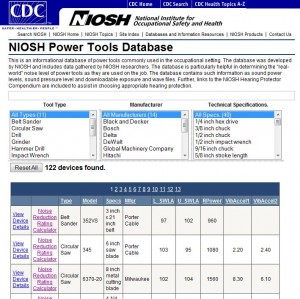 “Speaking on April 19 at the Experimental Biology 2009 meeting in New Orleans, Dr. Kristine Krajnak, a team leader in the Engineering and Control Technologies Branch of the Health Effects Laboratory Division of NIOSH in Morgantown, West Virginia, describes results from the first study to directly link the different physical responses of tissue that occur with exposure to different vibration frequencies with biological mechanisms underlying the development of vascular dysfunction. Her presentation is part of the scientific program of The American Physiological Society.
“Speaking on April 19 at the Experimental Biology 2009 meeting in New Orleans, Dr. Kristine Krajnak, a team leader in the Engineering and Control Technologies Branch of the Health Effects Laboratory Division of NIOSH in Morgantown, West Virginia, describes results from the first study to directly link the different physical responses of tissue that occur with exposure to different vibration frequencies with biological mechanisms underlying the development of vascular dysfunction. Her presentation is part of the scientific program of The American Physiological Society.
The study, along with results of other studies conducted by NIOSH, supports the importance of reducing job-related exposure to vibration. Ongoing research is evaluating the effectiveness of anti-vibration devices, such as anti-vibration gloves and tools.
Higher frequency vibrations produced by an electric sander (greater than 100 Hz) are smoother than the slower vibrations of an electric hand drill (approximately 63 Hz) and therefore are less likely to cause users discomfort.
Don’t let that fool you into not using protective devices that can reduce your exposure to vibration, she says. The new research study conducted at the National Institute for Occupational Safety and Health (NIOSH) suggests that exposure to high and low frequencies cause different physiological responses, but both may affect the risk of developing vibration-induced peripheral vascular dysfunction.
Of the 1.1 to 1.5 million U.S. workers exposed to hand transmitted vibration on a fairly regular basis, approximately half eventually develop some disorder such as Vibration White Finger, in which a single finger or sometimes the entire hand turns white and numb when exposed to the cold, due to restricted blood flow.
Workers also may experience reductions in tactile sensitivity, grip strength, and/or manual dexterity. Earlier studies have shown that risk goes up with frequency and duration of exposure, although NIOSH studies are underway to determine why certain people appear more susceptible to shorter exposure durations.
(more…)
![]() NIOSH has developed an online database of sound levels and vibration forces for various power tools typically used in the occupational setting. Developed by NIOSH researchers, the database provides information for over 120 power tools from manufactures such as Black & Decker, Mikita and Dewalt. According to NIOSH, “The database is particularly helpful in determining the ‘real-world’ noise level of power tools as they are used on the job.”
NIOSH has developed an online database of sound levels and vibration forces for various power tools typically used in the occupational setting. Developed by NIOSH researchers, the database provides information for over 120 power tools from manufactures such as Black & Decker, Mikita and Dewalt. According to NIOSH, “The database is particularly helpful in determining the ‘real-world’ noise level of power tools as they are used on the job.”

 “Speaking on April 19 at the Experimental Biology 2009 meeting in New Orleans, Dr. Kristine Krajnak, a team leader in the Engineering and Control Technologies Branch of the Health Effects Laboratory Division of NIOSH in Morgantown, West Virginia, describes results from the first study to directly link the different physical responses of tissue that occur with exposure to different vibration frequencies with biological mechanisms underlying the development of vascular dysfunction. Her presentation is part of the scientific program of The American Physiological Society.
“Speaking on April 19 at the Experimental Biology 2009 meeting in New Orleans, Dr. Kristine Krajnak, a team leader in the Engineering and Control Technologies Branch of the Health Effects Laboratory Division of NIOSH in Morgantown, West Virginia, describes results from the first study to directly link the different physical responses of tissue that occur with exposure to different vibration frequencies with biological mechanisms underlying the development of vascular dysfunction. Her presentation is part of the scientific program of The American Physiological Society.